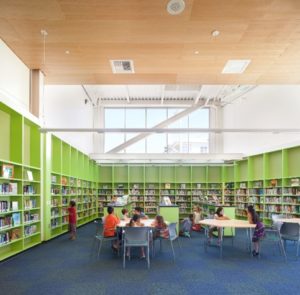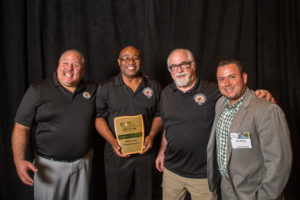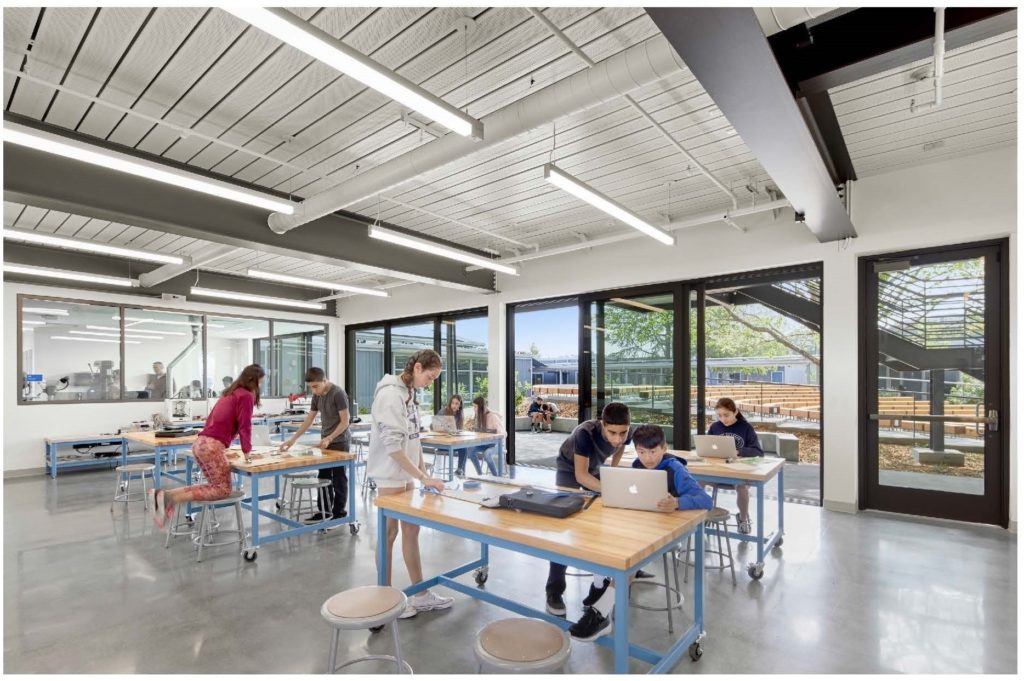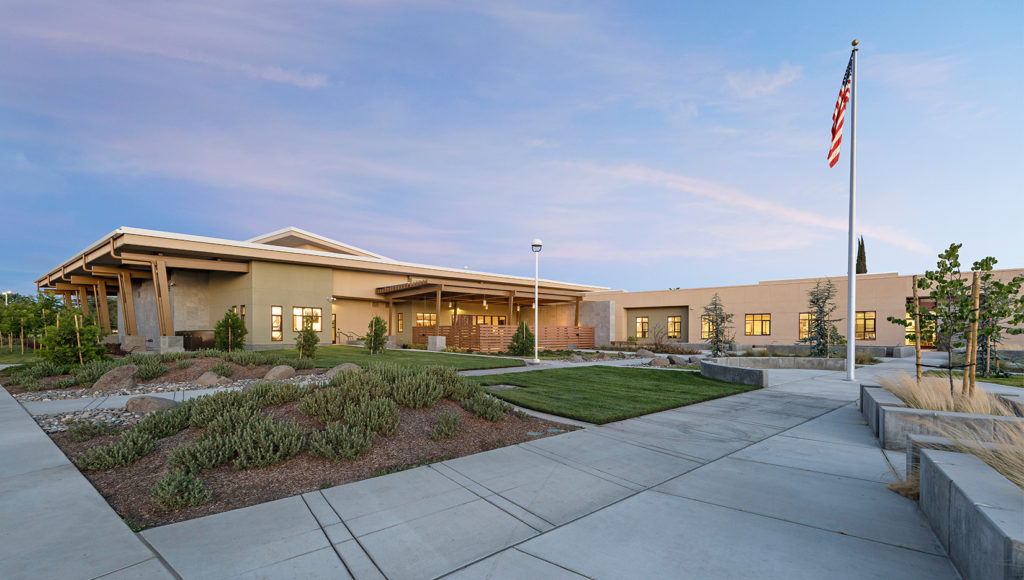Five exemplary individuals, school districts and school projects were honored with ZNE Schools Leadership Awards for their innovation and leadership in driving a new zero net energy (ZNE) standard for school environments. ZNE buildings represent high performance buildings that combine energy efficiency and renewable resources to produce at least as much energy as they consume annually, and California is leading the nation in the transformation of K-12 and community colleges to ZNE performance.
2018 Award Winners
Visionary Districts

Los Angeles Unified School District (LAUSD), Los Angeles, CA
A leader in ZNE efforts and ultra-low energy, LAUSD is committed to energy conservation through a variety of projects and policies that increase energy efficiency in district facilities, reduce reliance on fossil fuels, and increase conservation behavior through awareness and education. Christos Chrysiliou, LAUSD director of architecture and engineering, has led the development of six focus areas to integrate sustainability and ZNE goals into the District’s core educational mission. With these areas as guideposts, LAUSD remains focused on its commitment to becoming the most environmentally-friendly large urban school district in the nation. LAUSD has undergone installation of renewable energy sources such as photovoltaic panels that has a generating capacity of 21.5 MW–enough to power 3,500 homes for a year. Additionally, the District has invested over $141.5 million in energy efficiency from Prop 39 energy efficiency state grant funds. LAUSD is relentlessly focused on pursuing educational and green technology for the benefit of the students, teachers and its local community to develop healthy and safe learning environments.

Pittsburg Unified School District (PUSD), Pittsburg, CA
PUSD efforts represent whole school and district leadership in ZNE, sustainability, and the use of renewable energy. With 75% of its students receiving free and reduce meals, the District has chosen to pursue ZNE and other outstanding projects that prioritize student health, wellness and education. Alan Glass, Energy Supervisor for PUSD, has led the way in innovations, including introducing the Bioswale Solar and Wind Project and managing implementation of $2.7million in Prop 39 projects. Currently, plans are underway for a new elementary school that will be designed to ZNE with passive design strategies, a strong focus on daylighting and both rooftop and carport solar. In addition, new solar and wind generation resources at the Corporate Yard, where the facilities and maintenance department is housed, will power not just the Yard, but also the new electric vehicles in their fleets. The District hosts solar arrays at all 14 school sites, generating 5 gigawatt-hours (GWh) of electricity–over 53% of the district’s needs for the past 12 months.
Outstanding Buildings
Mark Day School, San Rafael, CA | ZNE EMERGING
The Learning Commons and Administration building is the fifth ZNE school by the same design team. It is an evolution from these prior projects with a goal of finding cost-effective design and construction strategies that are well understood in the industry, and are straight forward yet highly integrated. The goal is a replicable design that can become almost routine and broadly applied to school projects and similar buildings across the state. A high priority is the building performance in terms of acoustics, lighting and daylighting, indoor air quality, and thermal comfort because these measures have a tangible impact on students and teachers. A dedicated outside air system ensures that indoor carbon dioxide levels don’t spike causing students to lose focus. Attention to acoustics improves the ability of students to clearly hear and comprehend more of the classroom discussion. The project also includes a dashboard that documents energy production from PV system and the energy consumption of the key building loads.

Yosemite Community College District – District Office Building, Modesto, CA | ZNE VERIFIED
This project is the result of an inspired team working together to achieve high performance goals and set an example for future projects across the portfolio. The project employed an integrated design and community-driven process to achieve the ultimate ZNE goal. The design team worked together to analyze and verify appropriate energy-efficient strategies and team members contributed at each scope of work. They combined building siting, form, and envelope strategies with efficient mechanical and electrical strategies. Natural air circulation patterns were studied to maximize passive ventilation and the team also started the commissioning process in schematic design and continued through occupancy. The impact of these strategies proved substantial. The building provides an inviting environment that afforded the District the ability to collect all of the central services departments under one roof for the first time for a truly collaborative environment.

Foothill-De Anza Community College District (FHDA), Sunnyvale, CA | ZNE EMERGING Honorable Mention
Committed to high performance buildings and an early adopter of new technology exemplified in their LEED (Leadership in Energy and Environmental Design) buildings on both Foothill and De Anza campuses. FHDA receives this honorable mention because of their commitment to decarbonization of both large campuses–targeting 80% below 1990 emissions by 2030 through adoption of thermal microgrid technology and purchasing clean electricity. The architectural and engineering firms worked closely with FHDA to target high performance LEED Platinum as well as ZNE goals. The first Sunnyvale Campus building is an early instance of FHDA’s forward-looking goals to radically reduce greenhouse gas emissions through a combination of high building performance, electrification, and electrical energy derived from zero-emission sources.
ZNE Leaders
Alice Sung, Greenbank Associates
 As an architect and sustainability champion, Alice Sung has been an early adopter in ZNE and ultra-low energy, high performance schools for almost two decades. Her early work includes completion of the Chavez Education Center in Oakland (1999-2003) which has been recognized as one of the first California High Performance School (CHPS)-rated designs with low energy as a goal. Later, in her work as the high performance schools program manager and sustainability champion for Oakland Unified School District, Alice led the design team to the first ZNE-designed, CHPS-Verified Leader certified project in the state, the La Escuelita Education Center. She has always focused on maximizing natural daylighting and ventilation to develop healthy, low-energy buildings, towards ZNE and now to zero carbon. Her work has been centered on advocating for change in the built environment through policy development, design and implementation of high performance buildings, education and training, innovative funding pathways, behavioral change programs, and general advocacy
As an architect and sustainability champion, Alice Sung has been an early adopter in ZNE and ultra-low energy, high performance schools for almost two decades. Her early work includes completion of the Chavez Education Center in Oakland (1999-2003) which has been recognized as one of the first California High Performance School (CHPS)-rated designs with low energy as a goal. Later, in her work as the high performance schools program manager and sustainability champion for Oakland Unified School District, Alice led the design team to the first ZNE-designed, CHPS-Verified Leader certified project in the state, the La Escuelita Education Center. She has always focused on maximizing natural daylighting and ventilation to develop healthy, low-energy buildings, towards ZNE and now to zero carbon. Her work has been centered on advocating for change in the built environment through policy development, design and implementation of high performance buildings, education and training, innovative funding pathways, behavioral change programs, and general advocacy
